A two-day national conference on food packaging and its safety related aspects was held on 20-21 January 2016, at The Leela, Mumbai. The event hosted by Indian Institute of Packaging (IIP) saw 150 packaging professionals under one roof devising plans to meet the increasing demand of the food packaging sector.
A rough estimate suggests that the proposed 42 mega food parks by the government will yield a potential investment of about Rs 14,000 crore and should benefit 12.5 lakh farmers plus generate 3-4 lakh new jobs, too.
Plus, food sector is probably the single largest user of packaging; with 45-60% of the total packaging is consumed by the food sector world over. It is becoming increasingly important to develop an integrated system of packaging which is cost effective, has all the functional properties and makes it effective for distribution.
To address these, the two day national conference revolved around new developments in the packaging materials, techniques and systems, and regulations that open up new possibilities and opportunities for marketing products and reduce cost.
Topics ranging from the use of packaging materials such as paper, tin plate, glass, aluminium foil o the safe coatings used in packaging of food were discussed on day one. Akhilesh Tripathi, general manager at Hindustan National Glass (HNG), informs, “With the new NNPB technology glass packaging has become lighter and cost effective. The new glass bottle by HNG is 45% lighter.”
While, AB Kulkarni, managing director, Kaira Can Company, says, “Usage of PLC systems, microprocessors have revolutionised the can making process. Welding lines are now available for speeds from 100 to as fast as 800 cans per minute.”
With the growth in food packaging and awareness of the consumers, there is an increasing focus on regulatory aspects. Dr P Kartikeyan, assistant director regulations, Food Standards and Safety Authority of India (FSSAI) enlisted the requirements in packaging and labelling under the FSSAI Act.
The day two was focussed on addressing concerns about food safety, evaluation of packaging materials for safety and packaging systems and machinery used.
Jaychandran Nair, business manager – flexible packaging adhesives at Henkel, says, “All the components used to manufacture a packaging material have to fulfil the relevant regulation. This can be FDA, EU framework, etc. The entire value chain, right from the resin manufacturers to the end user, should understand the impact of raw materials in food safety.” Various requirements for efficient labelling for food packaging were highlighted by Rohit Mehta, corporate director at SMI Coated Products.
N C Shah, director at the IIP says, “The trend today is more towards fast-selling. Now, keeping the optimum shelf life as the base reference, we have to select a package which is cost-efficient and has optimum functional properties.” He adds, “Another important aspect of packaging today is consumer safety. It has become a big issue in the food industry. The product being packed should not react to the package.”
Expert Speak
E-MAP technology which is used to enhance the shelf life of fresh produce was the point of discussion during Shankaran’s presentation. Shankaran said, “E-MAP technology helps to preserve fresh produce and extends the shelf life of the produce by ensuring that the oxygen availability is reduced but maintaining a minimum level.” Shankaran introduces Flexfresh a patented biodegradable polymeric film invented by Uflex at the seminar. Uflex is currently exporting Flexfresh to the European, American and African markets. He informed that, Uflex has had a successful trial with Dominos, and has seen a shelf life extension from two to ten days.

N Siva Shankaran, vice president – business development, Uflex
During his presentation, Sarkar discussed the need to understand the various requirements in printing various packages. Technical requirements such as low odour, limited migration of unwanted substance to the packed material, and trouble free processing like UV coat ability of the inks used must be studied in depth. Sarkar said, “Safety in the packaging of food products needs special attention as more and more stringent regulatory requirements are now in place.” He stresses that the inks and coatings used to print food packaging must be manufactured in accordance with Good Manufacturing Practice (GMP) guidelines.

Prasanta Sarkar, general manager (technical), Hubergroup India
Chandak highlighted packaging machinery using the MAP (Modified Atmospheric Pressure) technology. In MAP packaging, atmospheric air is removed from the package and replaced with suitable gas or a gas mixture to extend the shelf life of the food packed.
Chandak said, "The USP of MAP packaging is the transparent films which allows clear view. MAP packaging can impart extended markets for sensitive food products and perishables." He explained the applications of these types of machinery which can be used to for the packaging of ready-to-consume snacks, convenience meal, fresh fruits and cut vegetables among others.
Vinay Chandak, CEO, Ace Industries
Ampady, presented a case study on how packaging has resulted in the socio-economic growth of the fisher folks in Kerala.
Fisheries is one of the important sectors in Kerala with 222 marine villages. KSCADC and the Central Institute of Fisheries Technology (CIFT) together established Fish Maid, a cold chain distribution model and Drish a brand for drying and packaging of dry fish; which traditionally were dried in unhygienic conditions. A Drish product uses a no touch, hygienic MAP packaging technique which has resulted in the extension of shelf life. "With this initiative, my dream is to find a place for regular products, without any taboo attached to it."
Dr K Ampady, managing director, Kerala State Coastal Area Development Corporation (KSCADC)


















 See All
See All